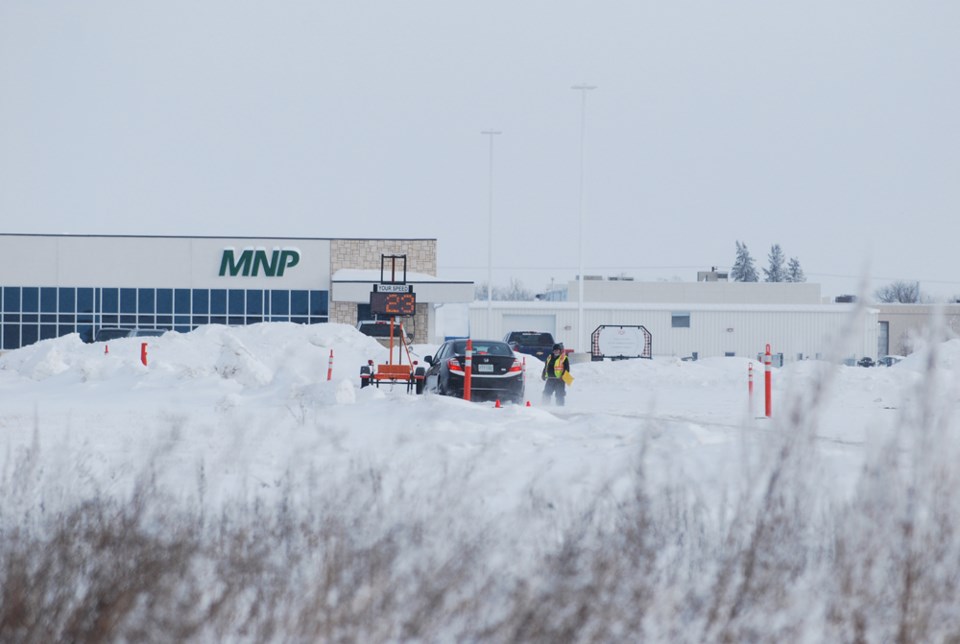The Saskatchewan Safety Council partnered with Discovery Ford to bring the Skidsmart Collision Avoidance program to Humboldt from Jan. 12-15 and Jan. 19-22.
The course was broken up into two parts; an in class discussion on skidding and a practical application portion where drivers got to go out and practice what they had learned.
“We simulate a lot of situations on our program that a person may not normally experience and all of the sudden they’re faced with on the roadways.” Says Skidsmart instructor Lee Carlson.
Winter driving conditions are frequent during a Saskatchewan winter but rarely are people faced with dangerous skids.
How do people handle the situation?
These are the situations drivers are not trained for, which means they could end up doing the wrong thing or panic suddenly endangering their lives and the lives of other drivers and their passengers.
This course prepares you for those situations before they occur, says Carlson.
The course was recommended to Janice Crawford who works in a government department. Many of her co-workers took it before and recommended it to others who do a lot of winter driving.
“The couple co-workers took it said it was just amazing. Really good course and learned lots of surprising things.”
Before getting out on the driving pad, Crawford was a bit worried because she brought a vehicle with a small wheel base.
After completing the course, her wheelbase and tires did make a difference but she still got a lot out of the course.
“It was an excellent, practical course with hands on opportunities to learn. Definitely learned I need new tires.”
What makes the program so beneficial, says Carlson, is that the practical application of the theory is part of the learning process.
A lot of programs do not have that, he says.
“Not only do we talk about it in theory but everything we discuss in the classroom is put to use out on the skid pad.”
There was a good balance between the in class and practical, says Crawford.
“You have to have the in class but the practical is where you get to try it.”
Statistically, more accidents happen at the beginning of winter because people are not used to the adverse driving conditions. Driving habits have to change quickly to deal with conditions from wet and slushy to snowy and icy.
“Quite often, most drivers can drive a vehicle but when they are faced with a situation, if they have to do a sudden maneuver, do they do it correctly?” Says Carlson.
Part of the program in the morning talked about what people do incorrectly when faced with a skid.
Over-braking and over-steering can cause drivers to lose control and make the situation worse which are the first things people do, says Carlson.
“That can actually cause a skid, or accentuate a skid that is already developing and it will affect your steerability as well.”
Steering during a skid should be done for control first, steering where you want to go and then braking only in a straight line.
Another reason people get into a skid is, “not using your eyes effectively,” says Carlson.
Scanning only the road in front of the car leaves the driver oblivious to the dangers that are up ahead.
Target fixation is another way a driver’s eyes can get them into trouble, says Carlson.
“(A driver) is faced with an object, what is the first thing they do? They look at the object. It’s a known fact you will steer where you look.”
Factors inside the car also play a role during a skid.
Seat position is one of them.
Having the seat too far back can cause people to lean forward when faced with a difficult driving situation. This can cause drivers to understeer when in a skid because they move their shoulders with the wheel, not making for an effective turn.
Hand position is another, which can also cause under or oversteering when the driver cannot see the wheel position in relation to the steering wheel, says Carlson.
Keeping hands at 9 and 3 keeps the driver aware of the directions the wheels are pointed when their vehicle is not exactly going in that direction.
“They’ll turn it one direction, and then when they get a reaction skid or have to turn the other way, they do hand over hand the other way.”
At this point, they do not know where their front wheels are pointed, says Carlson, so they oversteer.
The pad was not big enough for drivers to go at highway speeds but drivers could see the difference between a maneuver at 30 kilometres and a maneuver at 40 kilometres.
Even five to 10 kilometres can make a big difference when controlling your vehicle, says Carlson.
That is the biggest thing that people do incorrectly on the roadways, says Carlson, is go too fast for the road conditions.
“If we could get more people to slow down, adjust to the conditions, we could certainly have a lot less collisions.”




